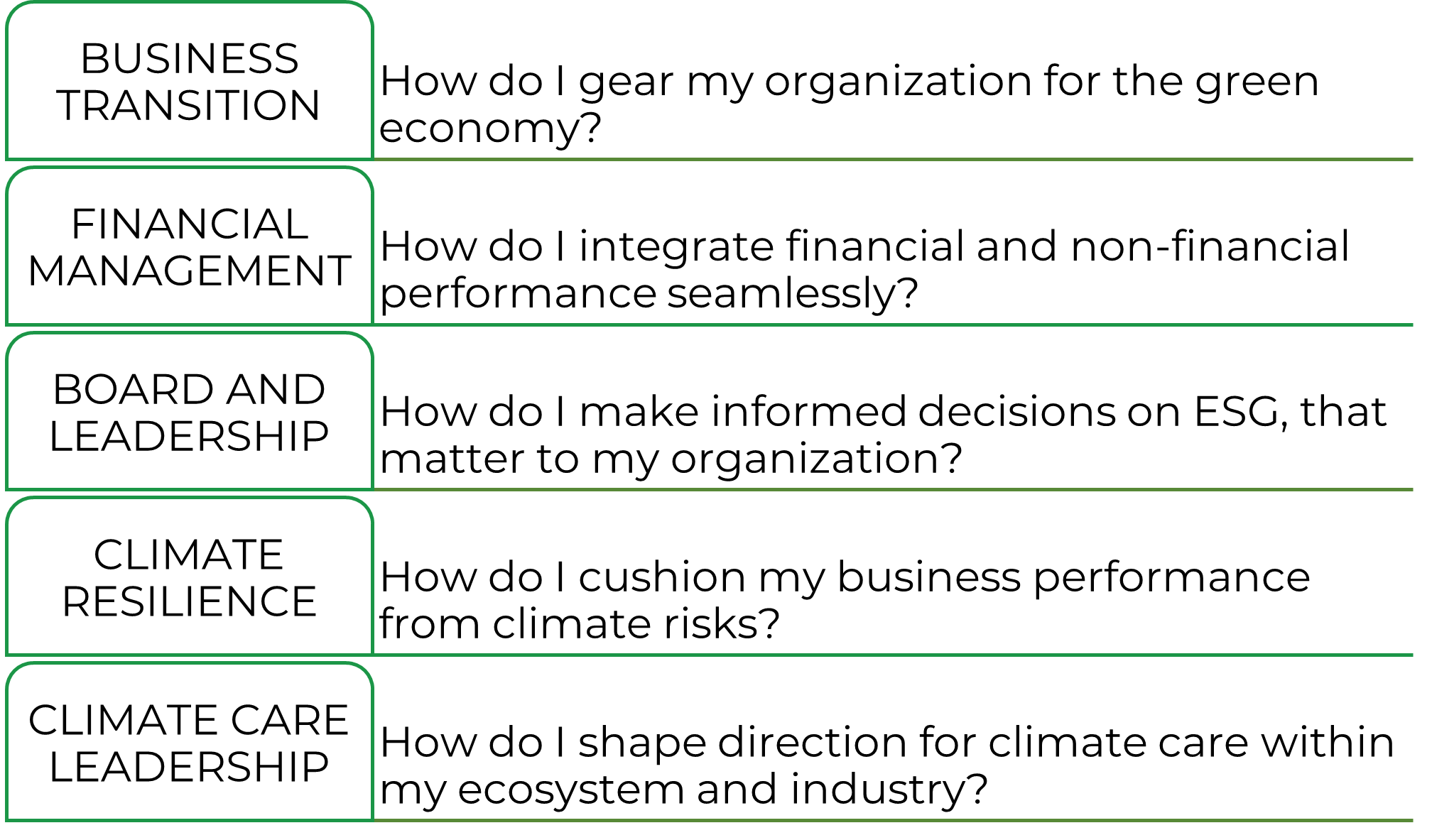
In any organization, those charged with governance and management carry significant responsibility. This remains relevant irrespective of whether they are leaders in the private sector or public sector, a multinational corporation or an SME. With sustainability increasingly becoming central to business strategy, the leadership team needs to bring the right perspective on the subject for informed decision making. These decisions, such as market entry, product/service redesign, newer offerings etc further drive the strategic direction of the organization.
Considering this imperative, the CEO is tasked with the responsibility to create value for its stakeholders consistently over time and minimize value erosion. Through this blog, let us explore the questions/topics that are demand the highest attention from the CEO today. In the process, we propose how these needs/challenges should be addressed.

1. How do I gear my organization for the green economy?
With each passing day, one hears about businesses exploring possible avenues to green their product/service offerings. This could be by introducing a completely new line of offerings, by innovating greener variants of products that are not substitutable, by revamping the existing business processes, and a lot more. From large behemoths to smaller enterprises, transitioning to a Green Economy carries significance to everyone. At the same time, these transitions cannot happen without a thorough understanding of their systemic impact.
We propose a Systems Thinking approach to ensure that every potential change or rewiring exercise in this transitional journey is thoroughly analysed. The execution models should consider the multi-stakeholder, multi-dimensional and multi-year aspects of business transition and accordingly determine the roadmap. Due consideration should be given to Just Transition to ensure that both the internal and external stakeholders are not adversely impacted with the shift. Establishing these safeguards upfront gives your business the best chance of a successful transition to benefit from the Green Economy.
2. How do I integrate financial and non-financial performance seamlessly?
Businesses have long held profit-making as the north star to determine their strategic and tactic moves. This will continue to be the primary driver, while the ESG parameters gradually gain more significance. The time has come for the talk about triple bottomline to be put to action. The greenline has to align with the topline and bottomline and can no longer be seen in isolation.
We propose that appropriate KPIs that align the non-financial indicators with your financial dashboards are evolved. Further, it is important to identify financial levers like carbon pricing and carbon dividends that could be used to manage behaviours across the operational teams, to drive your carbon footprint down. This needs to be combined with efforts to develop an integrated message for your stakeholders about the financial and non-financial performance of your organization.
3. How do I make informed decisions on ESG, that matter to my organization?
With the agenda of Corporate Sustainability acquiring strategic significance, it requires clear direction from the top leadership. It requires a strong alignment with performance goals of the organization and the associated KPIs of the leadership team. This absolute commitment and clarity from the board and leadership team is the only way to drive the alignment and shift across the hierarchy. While this is no debate on the need, today's Board and Leadership teams are, in most cases, not equipped with the right information on Climate science within that core group. There are several facets of sustainability that require multi-dimensional oversight, contextualised application and limited reliable expertise just makes it tough.
We propose to bring in strong representation of ESG/Climate Change/Sustainability knowledge on the governance and executive management teams. This could be a leadership hire, an independent director, or an external advisory. The bottom line is a strong acknowledgement that the Board and Leadership teams provides direction in the value creation process and this needs to be comprehensively informed for the current times.
4. How do I cushion my business performance from climate risks?
Enterprise risk management has always played a significant role in ensuring business strategy and operations are firmly safeguarded. Over the last few years, climate-related risks have started acquiring a whole new meaning. Businesses have witnessed significant disruptions to operations across the supply chain, due to climate emergencies and the pandemic. It is no surprise that investor community is also channelising their inflows towards companies that have strong risk evaluations in place for ESG related challenges.
We believe driving Climate Resilience needs a comprehensive approach including an all-round assessment of related risks and a strong alignment with Enterprise-wide risk management procedures. We propose that climate-related risks assessment uses a 3-dimensional approach that studies each risk to understand its impact, its likelihood, and the time-horizon. This needs to be combined with industry-accepted methods for Risk Management. Further, conducting Scenario analysis helps ensure that you do not base our assessments purely based on past data of frequency and intensity.
5. How do I shape direction for climate care within my ecosystem and industry?
With the world looking for answers to address the climate crisis, a significant part of the onus lies with the corporate leaders of today. They must establish the right governance procedures and policies to ensure that they do not let the immediacy of addressing the issue overpower the efficacy of planned solutions. Your organization can be a true Climate care beacon of light for all stakeholders, only if you your approach passes through the governance test, i.e. no intentional or unintentional greenwashing or goodwashing.
We believe this level of maturity requires strong planning, execution, and evaluation of the climate care initiatives. To make this happen, organizations need to assess their maturity today before planning their roadmap. This needs to be done with due consideration to globally recognized standards, frameworks, and best practices. Such roadmaps should be phased and progressive, gearing you up as the Influencer within your operational ecosystem and the industry.
With the CEO holding the steering wheel, his actions determine how the team across the hierarchy and the stakeholders in the ecosystem approach Sustainability. At the same time, he is highly dependent on his peers and the team to implement the strategic directive. For relatively smaller companies that may not have an exclusive office for the Chief Sustainability Officer, the CEO’s agenda should also encompass the CSO’s agenda for a holistic coverage.
Watch this short video from Sus360 Bytes that summarises the CEO's Sustainability agenda.
